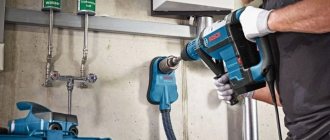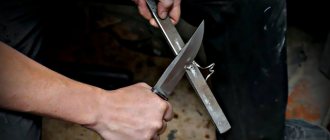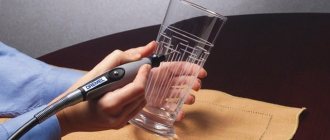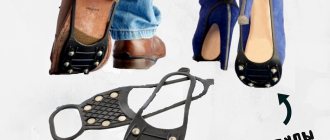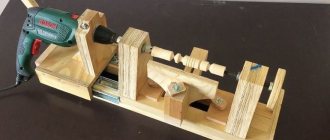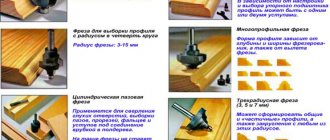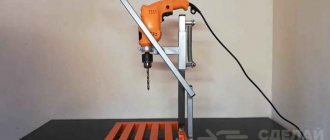Even the most reliable branded power tool, such as an electric drill, hammer drill or screwdriver, not to mention a Chinese-made tool, wears out over time, depending on the intensity of use, and begins to hold drills and bits poorly, or the chuck jams.
The same fate befell the chuck of my electric drill, which has been serving faithfully for more than 12 years. The malfunction began to manifest itself with jamming, resulting in difficulty in rotating the release ring. In addition, water got inside the cartridge during the renovation of the apartment, and a coating of rust appeared in the guide grooves of the cartridge cams. The working surfaces of the cams are also worn out. Although the drill chuck was still working, changing drills was extremely inconvenient. I decided to replace it with a new one, and then the question arose, how to remove the chuck from the drill shaft?
Collet chuck device
The design of the collet chuck is quite simple. The main part of the equipment is a collet, a special device in the form of a sleeve with longitudinal cuts. These cuts form springy petals that securely hold the workpiece. There can be three, four, six or more petals, depending on the diameter of the sleeve.
Mechanical engineering companies usually use ER type clamps. These parts have two clamping zones along the axis. Therefore, the tool placed inside is rigidly fixed, and there are no radial runouts, so they are not even taken into account in the calculations.
Image No. 1: Collet chuck design
Serial collet chucks are made of hardened tool steel and have high strength and wear resistance. Homemade clamps are made from bronze, brass, aluminum and steel.
How is a collet chuck different from a jaw chuck?
Collet chucks, like jaw chucks, are holders for tools and workpieces, so they are often confused. However, these equipments have fundamental differences. Jaw chucks are considered more universal and can therefore be used to hold tools with shanks of different diameters. On the contrary, collets are designed to work with certain diameters and are not suitable for tools with other shanks.
Jaw chucks
The most convenient and functional. They work both in compression and expansion, so they can grip the workpiece both from the outside and from the inside. They differ in the number of jaws and their drive mechanism. Unlike metalworking, two- and three-jaw chucks are practically not used for turning wood. Options with a spiral drive and non-removable jaws are also not popular. The most common type of lathe chucks for woodworking are self-centering four-jaw, with a rack-and-pinion transmission mechanism and replaceable jaws. They are supplied to the Russian market by the brands Axminster, Jet, Barracuda and others, less well-known companies.
Types of cams
According to their shape and purpose, replacement jaws for wood lathe chucks are divided into several types, which have special markings:
- A, G, M – for compression, differ in size and depth of grip;
- D and F – act on unclenching;
- C and H are universal. Different shapes of sponges;
- To work with soft, compression-sensitive wood, cams with rubber fastenings are used.
How does a collet chuck work?
We'll tell you how a collet chuck works, which is used on lathes and hand tools.
The equipment consists of several collets and a self-clamping nut, which applies pressure to the end of the cartridge. Due to the applied force, the collet moves into the sleeve, decreasing in size, and its petals are compressed and securely fasten the tool shank or the workpiece. To remove the workpiece, the nut is unscrewed, thereby increasing the diameter of the collet.
The main advantage of the equipment is its ability to be perfectly centered, which is why the tool fixed with their help has minimal radial runout. And there is no need to use keys to operate the clamp.
Do it yourself
To understand how hand tools for woodworking are made, let's look at the manufacturing process of several of their main varieties.
Meysel
This is the main tool used for finishing wood workpieces. In skillful hands, this chisel is enough to create any pattern.
A straight-sharpened meisel is ideal for creating rectangular notches in a workpiece. Its width varies from 4 to 40 mm, the standard sharpening angle is from 22 to 45. The required blade slope is determined by the personal preferences of the master over time.
How to make it:
- We take an old file or any other flat rectangular piece. If necessary, align the working end;
- We grind the cutting part, carrying out primary turning. We use an abrasive wheel, making sure that the blade is processed evenly in thickness without differences;
- We harden if the metal is not hard enough;
- We put the handle.
This type of chisel is easy to prepare and can be used to start creating your own collection of hand tools to gain experience and understand the process.
The Meisel with a beveled blade is more versatile than its counterpart:
- It becomes possible to process round products;
- An obtuse angle is suitable for creating roundings;
- The tool is convenient for processing the end of a product.
Manufacturing is similar to the previous device:
- The blank part is processed to the shape of the future tool;
- The chisel is sharpened at an angle of 70-75, after which the tool must be sharpened.
- We attach the handle. Meisel is ready.
Using a similar algorithm, the remaining angular cutters for a wood lathe are created. Sharpening is carried out only after careful control of the tool dimensions.
Maintaining exact angles when making tools yourself is not necessary. It is enough to adhere to the necessary and convenient proportions and evenness of processing.
Semicircle
The semicircular tip of the chisels allows you to create neat notches when processing a wooden product. To make such a cutter, we mark on the workpiece the outline of the tool along which we cut. After this, we sharpen it at an angle of 25...40 in the usual way.
The radius of the chisel affects the size of the recess in the product, therefore for professional production it is advisable to make several cutters with a semicircular tip for different cases.
Groove
After stripping the bark, the wooden trunk is processed with grooved chisels; they are intended for the initial rough finishing of the material and creating a blank for the product.
In addition, grooves are used to cut concave shapes and recesses in frontal turning.
How to make a groove cutter:
- Take a tap to cut a thread of the required diameter.
- We process the metal blank with it at a distance of up to 8-10 cm from the edge, actually cutting off half of the rough product.
- We sharpen the lower convex part of the blade at an angle of 30-40.
Grooved homemade wood turning tools are not easy to make, but it is quite possible to understand the process.
Make or buy
The process of creating tools for working with wood is a fascinating and not always easy task. If you have the right set of tools, an inexperienced person will not have any problems - the process is intuitive, but painstaking.
Of course, you can buy a ready-made set of devices, but how much will it cost... At the same time, the wear of the metal increases over time and even brand new chisels will soon require turning. Own production is a way to get a tool under your own hands. Designer cutters with individual sizes will be adapted to the owner and his needs.
A more detailed description of the chisel making process is presented in the video. The master talks in detail about creating a workpiece, applying sharpening and touches on other important points that are necessary for the successful completion of the work.
Designation of collet chucks
The designation of a collet chuck with an outer cone, intended for fixing a tool with a cylindrical shank, in the drawing is as follows.
Image No. 2: Collet for a universal machine with a cone number 50, diameter under the shank (d) 12 mm, length 90 mm
The table below shows the standard dimensions of collet chucks, which are important to take into account in the calculations:
| Cone designation | D | d | l, no more |
| 30 | 31,75 | from 2 to 12 | 90 |
| 40 | 44,45 | ||
| 50 | 69,85 | ||
| 30 | 31,75 | from 10 to 25 | 100 |
| 40 | 44,45 | ||
| 50 | 69,85 | ||
| 30 | 31,75 | from 15 to 40 | 110 |
| 40 | 44,45 | ||
| 50 | 69,85 |
Current GOSTs
The main current standard related to this type of equipment is GOST 26539-85. It introduces the characteristics and markings of the 7:24 external taper collet chuck. And the Resolution of the USSR State Committee on Standards No. 5943 gives the following recommendations:
- graphic designations of supports, clamps and installation devices (including collet chucks) used in technical documentation;
- To display supports and clamps, solid thin lines are used (GOST 2.303-68).
Jaw chucks
The most convenient and functional. They work both in compression and expansion, so they can grip the workpiece both from the outside and from the inside. They differ in the number of cams and their drive mechanism. Unlike metalworking, two- and three-jaw chucks are practically not used for turning wood. Options with a spiral drive and non-removable cams are also not popular. The most common type of lathe chuck for woodworking is self-centering four-jaw, with a rack-and-pinion transmission mechanism and replaceable jaws. They are supplied to the Russian market by the brands Axminster, Jet, Barracuda and other, less well-known companies.
Types of cams
According to their shape and purpose, replacement jaws for wood lathe chucks are divided into several types, which have special markings:
- A, G, M – for compression, differ in size and depth of grip;
- D and F – act on unclenching;
- C and H are universal. Different shapes of sponges;
- To work with soft, compression-sensitive wood, cams with rubber fastenings are used.
Making a collet chuck for hand tools and machine tools
The simplest homemade collet chuck for hand tools can be created without using a lathe. If you need equipment for a machine, it will have to be machined from a workpiece and you cannot do it without special knowledge.
Method 1. The simplest wire collet
To equip a drill with low engine power, which will be used to work with wooden and plastic workpieces, a miniature collet coupling soldered from steel wire is suitable. It is important to consider that the resulting chuck can only be used for drills of the same diameter, and the diameter of the drill must correspond to the output shaft of the motor.
Photo No. 2: The simplest collet clamp made of wire
For work you will need the following tools and materials:
- a cylindrical metal blank, the diameter of which coincides with the diameters of the output shaft of the motor and the drill;
- steel wire 1 mm thick;
- electric soldering iron;
- soldering flux or KFET.
The wire should be wound around a blank, forming a rigid spring. The turns of wire must be placed as close to each other as possible. The finished spring is soldered directly on the workpiece using flux or KFET.
The resulting collet coupling is put on the electric motor shaft, and a drill is inserted into the hole at the opposite end.
Method 2. Collet clamp from a screw
A collet chuck with similar characteristics can be made in another way. The product will consist of two parts connected by a screw. Fixation of the clamp on the shaft of the electric motor and the tool is ensured by cylindrical grooves on the internal surfaces of the equipment.
Photo No. 3: Blanks for making a collet clamp
To work you will need:
- 8 mm bolt or screw;
- closed nut M8;
- grinder with a metal disc;
- drill and drill bits 2 and 5 mm.
Photo No. 4: A collet chuck made from a screw mounted on an electric drill, in use
Drill a 3mm hole in the bolt leg. Make two even axial cuts crosswise with a grinder or a hacksaw. After this, drill a hole with a diameter of 2 mm in the closed nut exactly in the center. Extend it to 5mm. Round the edge of the bolt to create a cone. The finished collet chuck must be centered before use. Only in this case will it work correctly.
Method 3. Homemade collet chuck for a milling machine
A homemade collet chuck for a milling machine can be made on a lathe. For equipment you will need a steel blank (round timber with a diameter of 40 mm and a height of 70 mm). The work is carried out in two stages. First, the cartridge body is made, then the clamping nut.
Photo No. 5: Collet for a milling machine, turned on a lathe
Manufacturing of the cartridge body:
- Clamp the blank into the chuck with reverse jaws.
- Drill a through hole in it along the axis and bore it.
- Cut a M27 x 2 thread in the hole.
- Grind the outer surface of the blank.
- Trim the end that will support the base bearing surface on the spindle.
- Remove the resulting mandrel from the chuck and the three-jaw chuck from the machine and screw the mandrel onto the spindle until it stops.
- Bore the cylindrical and conical surfaces of the collet socket.
- Grind the end of the mandrel and cut a thread in it for the clamping nut.
Making a clamp nut:
- Clamp the workpiece into the reverse jaws of the three-jaw chuck.
- Drill a hole in it, bore the internal cavity.
- Grind the inner end bearing surface.
- Cut a counter thread in the nut.
- Screw the nut onto the chuck previously installed on the machine spindle.
The resulting equipment can be improved to make it easier to fix the tool. For this purpose, grooves are rolled on the side surfaces of the cartridge body and nut and grooves are made in the outer side surfaces.
We remove cartridges with their various connections + (Video)
To remove a chuck that is screwed onto a tool, do the following:
1) There is a screw inside the cartridge located in the middle of the device. This screw has a left-hand thread.
2) To unscrew the screw, you will need to use a Phillips head screwdriver.
3) It must be unscrewed in the clockwise direction, that is, to the left.
4) After unscrewing the screw, which may not be present on some drill models, it is necessary to unscrew the unit that serves to fix the working element. Unscrewing is carried out by rotating the unit to the right.
To make it easier to remove the chuck, it is recommended to clamp the drill in a vice. If you cannot unscrew it manually, you can use a pipe wrench or a hammer, following the procedures described in the section on removing a jammed drill.
Such popular manufacturers of power tools as Interskol and Makita have a similar design for securing cartridges on drills and screwdrivers. Therefore, all that is needed to unscrew the cartridge is to determine the type of connection and then use one or another method to remove the cartridge.
Makita drill with keyless chuck and threaded connection
When removing a cartridge with a cone connection, there are often no problems at all. The simplest way is to carry out the work using a hammer. It is used to dislodge the structural element from its engagement. The drill must be secured in a vice so that the chuck faces down. After this, blows are applied to the back of the cartridge, thereby dismantling it.
Drill with various cones for securing the chuck
Attaching the collet chuck to the machine and hand tools
The collet chuck is mounted and centered on the lathe spindle. Note that the diameters of the cartridges and methods of their installation are standardized. The most common spindle end designs include Type C and Type D (cam-lock) fasteners. Also, to install collet chucks, flanges and faceplates are often used, which are placed on the spindle.
Now we will tell you how to center a collet chuck on the motor shaft of a hand tool (electric drill). The adjustment is carried out in two planes, and first the runout is eliminated in one plane, then in the other. Work progress:
- Fix the drill on the table (in a lying position).
- Rotate the chuck until the desired pair of bolts is parallel to the table.
- Rotate the chuck 180 degrees and note the deflection of the chuck.
- Eliminate wobble by tightening and loosening a couple of screws.
Do the same with the second pair of screws. To make the deviation in two planes more noticeable, use a long drill.
What is the function of the chuck in a drill?
The drill chuck is one of the main components of the electric drill mechanism. It serves to transmit rotational motion from the electric motor to the working tool. Its task also includes fixing the drill in such a way that during operation the maximum accuracy of drilling holes, reliable fastening and quick replacement of the tool are observed.
In any drill, the tool is fixed in a chuck
Attaching the chuck to the spindle of an electric drill
Actually, there are two methods of fastening:
- cone mate;
- threaded connection.
You can find out the type of fastening by the marking:
- the inscriptions B10, B12, B18, etc. characterize the parameters of the Morse cone, the special shape of the mating surfaces (in total there are 9 standard sizes from B7 to B45); before this designation, the range of drill shank diameters is marked, for example, 1−6 B10;
- type designations 1−15 M13×1.3; characterizing the parameters of metric threads (diameter of drill shanks, thread diameter and thread pitch);
- abbreviation UNF (the full marking is similar in structure to the marking of metric threads, for example, 2−13 mm ½ - UNF, where ½ denotes the diameter of the thread in inches, and the number 20 characterizes the number of threads of thread per length of one inch), which indicates fastening using an inch thread ; this type of connection is typical for imported instruments.
How to assemble according to drawings yourself
For a beginner to work on metal, it is possible to assemble a home-made chuck, but the whole process will become a headache due to searches, inconsistencies, errors, etc. Making a lathe chuck for woodworking is much more affordable, although not easier as it might seem.
First of all, for the work to proceed, it is necessary to create a detailed assembly drawing with detailing drawings. After the drawings, events will follow. Without drawings and an action plan, it is unlikely that anything worthwhile will be achieved, because anyone who acts without a plan acts for a long time and poorly.
Then the process of collecting components and materials begins. The process of implementing ideas is the most reverent and carries with it a powerful stream of self-renewal. And successful completion becomes another favorable stage in creative life.
How to choose
To choose the right lathe chuck, you need to consider several important points:
- operating parameters and exact dimensions of the machine spindle;
- method or option for attaching the chuck to the spindle;
- for hobby machines, drive power plays an important role; a weak engine may not cope with the torque task;
- what and how many parts are included in the lathe chuck kit.
Without a clear understanding of the information presented above, you cannot consider yourself ready to purchase a lathe chuck as an important component of the machine. You need to understand that the quality and productivity of a lathe affect the quality and productivity of labor and material condition
You need to understand that the quality and productivity of a lathe affect the quality and productivity of labor and material condition.
How to assemble according to drawings yourself
For a beginner to work on metal, it is possible to assemble a home-made chuck, but the whole process will become a headache due to searches, inconsistencies, errors, etc. Making a lathe chuck for woodworking is much more affordable, although not easier as it might seem.
First of all, for the work to proceed, it is necessary to create a detailed assembly drawing with detailing drawings. After the drawings, events will follow. Without drawings and an action plan, it is unlikely that anything worthwhile will be achieved, because anyone who acts without a plan acts for a long time and poorly.
Then the process of collecting components and materials begins. The process of implementing ideas is the most reverent and carries with it a powerful stream of self-renewal. And successful completion becomes another favorable stage in creative life.
Equipment order
Well, are you ready? It's time to start loading your own cartridges. However, do not forget to prepare your workplace before doing this. A regular table with plenty of free space is best suited for this purpose. Also, do not forget that it is important to be careful and attentive during the work process.
Installing the capsule
First you need to insert the primer into the cartridge. If you are using an already fired cartridge case, be sure to make sure that there are no defects in the igniter hole, otherwise the cartridge case will wear out during the firing process. The capsules must be installed using the Sidorenko universal device. It is important to insert the parts evenly so that there are no distortions. Some hunters bury the capsule 0.1-0.2 mm deep. However, this practice is relevant only if the size of the striker allows this to be done.
To remove punctured primers from spent cartridges, also use the UPS. For this purpose, the device has a special needle-type device. It is enough just to straighten the “neck”, after which the spent capsule is quite easily removed.
Loading gunpowder
Once the new primer is in place, you can begin loading powder into the case. To do this, we first calculate the required weight (or follow the recommendations indicated by the manufacturer on the packaging), and then measure the required amount using electronic scales. We insert a funnel into the cartridge and carefully pour gunpowder into the cartridge case. Don’t forget to compact it afterwards using a sealer. However, excessive force will also be unnecessary, so use only your hands (several kilograms of pressure).
Installation of gaskets and wads
Once the gunpowder is poured in and pressed in, you need to compact it using a wad, which you made yourself by die-cutting or purchased at the store. If you use a felt seal, be sure to place a cardboard pad under it to prevent the wad from mixing with the gunpowder. 1 to 2 gaskets are also installed on top of the seal (depending on the thickness of the material). To make it easier to send wads and gaskets inside the cartridge, you can use a navoynik. However, do not overdo it (after all, this is a rammer, not a press).
An important note: in brass cases it is recommended to use wads that are 2-4 calibers larger than the cartridge. That is, if the sleeve has a size of 15.6 mm (16 gauge), then the wad should be 18.5 mm in diameter (12 gauge). This must be done due to the fact that in metal casings the wads fall inward over time, thereby forming a layer of air between the gunpowder and the shot. There is no need to carry out such manipulations with plastic and paper sleeves, since the wads in them adhere well to the rough walls.
Loading Fraction
Once the wad and spacers are installed, you can begin loading shot. So that you do not have to constantly measure the required amount of the damaging element on the scales, it is recommended to use special measurements. As for purchased bullets, detailed instructions for loading them are described on the paper that comes with the ballistic projectile. Typically the weight of one 12 gauge bullet is 32 grams (±2 grams). That is, in order for the bullet to have good ballistics, at least 6 grams of Sokol gunpowder will be required.
Rolling the chuck
After all the main elements are placed inside the sleeve, it is necessary to proceed to the final stage of the equipment - rolling the sleeve. This is done so that shot or buckshot does not spill out during the transportation of ammunition. Folder sleeves are the easiest to roll, since you just need to install a cardboard spacer and then screw the edges of the cylinder so that it does not fall out. The same can be done with plastic, but most often plastic sleeves are rolled using an asterisk.
You can roll brass sleeves using a special machine, which will cost a pretty penny. Plasticine or paraffin is usually used as a gasket. You can also buy special plastic plugs from the factory or try to glue the gaskets with glue. Be that as it may, you will have to suffer with rolling the brass.
Ammunition marking
After the cartridges are rolled, it is recommended to mark them, so that later you do not forget what kind of shot or what weight of gunpowder is used in certain cartridges. You can do this using a regular felt-tip pen in any way convenient for you. Also, for large shot (3-1 numbers) you can use red sleeves, and for smaller shot (7-4 numbers) - blue. You can also purchase special stickers that are simply stuck on the sleeve (all the necessary information is already printed on them).

